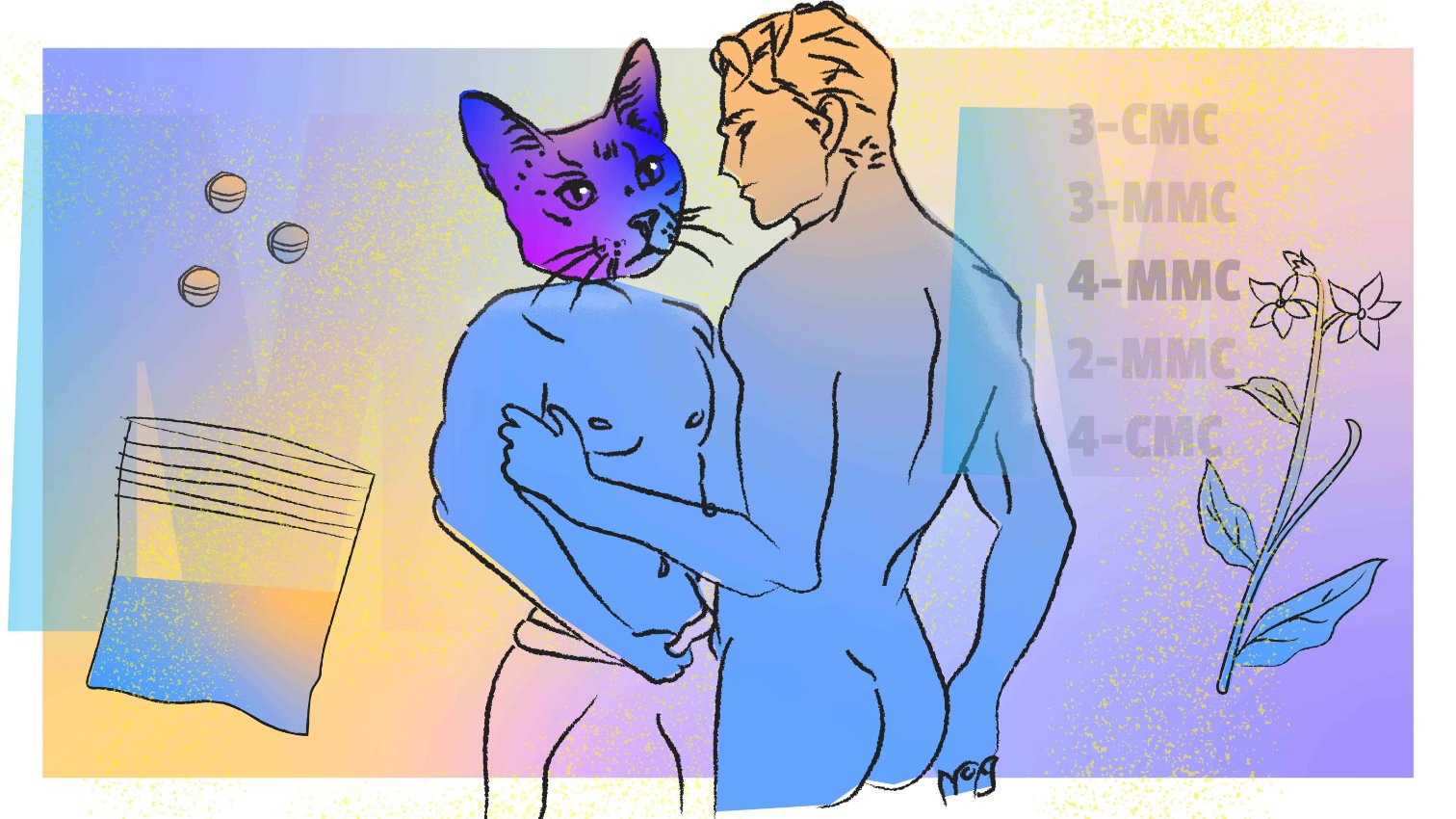
Quick Facts 
Mephedrone, also known as 4-methylmethcathinone (4-MMC), is more common in chemsex outside of Sweden. Chemically altered variants of 4-MMC (3-MMC, 3-CMC etc.) are becoming more common.
The substance is also referred to as Meow Meow, M-Cat, Drone, or M. Mephedrone is a central stimulant with effects similar to amphetamine and MDMA (ecstasy) as it belongs to the same chemical class as these (cathinones).
⬆️ Mephedrone is an ‘upper’ often used for its euphoric and stimulating properties.
🔴 There is a high risk of psychological dependence associated with mephedrone use. Many users experience strong cravings after taking mephedrone.
What does it look like?
Mephedrone, also known as 4-methylmethcathinone (4-MMC), is a synthetic stimulant that typically appears in the following forms:
Powder: Mephedrone is usually a white or yellowish powder. The texture can vary from fine to more crystalline.
Crystals: It can also appear in larger crystalline forms, resembling small, transparent, or white crystals.
Tablets and capsules: Sometimes mephedrone is sold as tablets or capsules. The tablets can be white or various colors and sometimes embossed with logos or symbols. Mephedrone can also be found in capsules, with the powder enclosed in a gelatin or plant-based capsule.
Regardless of the form, mephedrone often has a chemical smell reminiscent of cat urine or flowers.
How is it used?
Users typically take the drug by snorting the powder, swallowing capsules or tablets, or sometimes dissolving the powder in liquid and drinking it.
How does it feel?
Using mephedrone can produce intense physical and psychological experiences, ranging from euphoria and energy to increased social interaction and sexual arousal.
However, it can also cause effects such as heart palpitations, muscle tension, and subsequent fatigue and depression.
Mephedrone use should always be approached with caution, aware of the potential health risks and negative side effects.
🕐 The effects of mephedrone usually do not last very long (about 2-4 hours), which can lead users to take repeated doses over a short period to maintain the high.
What is 3-MMC and 3-CMC?
3-MMC (3-Methylmethcathinone) and 3-CMC (3-Chloromethcathinone) are both synthetic cathinones. Both substances are chemical modifications of 4-MMC, and are manufactured to bypass drug classification by slightly altering their chemical composition.
3-CMC has gained popularity after 3-MMC became classed as narcotics. In Sweden it has become more prevalent, especially during the pandemic (covid-19) as the substance was easily ordered online.
It can be hard to keep track of what ‘substances’ are legal or not. Many have been under the impression that 3-CMC is legal, but both 3-CMC and 3-MMC are classed as narcotics in Sweden.
⚠️ Substances are often sold online under “mephedrone” or 3-MMC but the actual variant of the drug may be 3-CMC or another chemical composition. With new substances the risk is higher as the effects and possible dangers are less known.
According to users, the high from 3-MMC is more stimulating and less intense compared to 4-MMC. This could lead users to take higher doses to compensate. While 4-MMC has a similar effect to MDMA, 3-MMC is more similar to cocaine.
Mephedrone and sex
Mephedrone is used in chemsex contexts, particularly among men who have sex with men (MSM) and transgender women.
- Mephedrone enhances sexual arousal and can intensify the sensation of sexual pleasure, leading to longer and more intense sex sessions.
- Users often experience a strong sense of connection and social interaction, making it easier to form emotional and physical bonds with others.
Risks and side effects
Increased sex drive and reduced inhibitions can lead to crossing boundaries and taking risks that one would not normally take when sober. This can include having sex with multiple partners, not using condoms, engaging in sexual activities beyond one’s comfort zone, and having difficulty communicating with partners about safer sex (harm-reduction). These factors can increase the risk of sexually transmitted infections (STIs) and HIV.
It is important to remember that harm-reduction and strategies for safer sex vary from person to person
The combination of mephedrone with physical exertion during sex can increase the risk of dehydration, overheating, and heart problems.
After the effects of mephedrone wear off, users may experience severe depression, anxiety, and a sense of emptiness, which can negatively impact mental health.
Safer sex with mephedrone
- Sex on mephedrone can be more aggressive; use only enough to recognize your partner’s defense signals and to protect yourself.
- The sex can last much longer since the sense of pain and touch is reduced, making it harder to climax. If using a condom, change it after 30 minutes to avoid wear and breakage.
- Ensure you have everything needed, such as condoms, lube, gloves, and cleaning supplies for sex toys.
- When on mephedrone, you might do things you normally wouldn’t; talk with your partner(s) beforehand about what sexual activities are acceptable and what are not.
Managing an overdose

Symptoms of an overdose include:
- Severe agitation and anxiety
- Hyperthermia (elevated body temperature)
- Serious heart issues such as tachycardia, high blood pressure, and potential heart attack
- Seizures
- Psychotic episodes
Always take signs of overdose very seriously. If an overdose is suspected:
- Call for an ambulance: Dial 112, Sweden’s emergency number, which also works in all EU countries. Inform them that you suspect an overdose and describe the symptoms as accurately as possible. It’s crucial to be honest about what and how much the person has taken, as this helps medical staff provide the right care quickly
- Keep the person awake and calm: If possible, try to keep the person awake and calm. Ensure they are breathing and keep their airways clear. Sit or lay them in a comfortable position. If they are unconscious, place them in the recovery position to keep the airways clear and reduce the risk of choking
- Keep the person cool: Ensure the person is in a cool environment; you can open windows, doors, or turn on a fan. Use cool, damp towels on areas where major blood vessels are close to the skin, such as the neck, forehead, armpits, and groin. Offer water in small amounts. Avoid using extremely cold water or ice directly on the skin, as this can worsen the condition
- In case of seizures: Protect the person from injury during the seizure, but do not hold them down. Place something soft under their head, ensuring it doesn’t obstruct their breathing. After the seizure, lay the person on their side with their head slightly tilted back (this helps with breathing and allows saliva to drain from the mouth)
- Stay with the person: Regularly check their breathing and pulse. If breathing becomes irregular or stops, or if the pulse is weak or cannot be felt, you may need to perform CPR. If you’re unsure how to do this, follow the instructions from the emergency operator (112)

🔗 Addiction risk

- Mephedrone can produce a strong and rapid sense of euphoria, making users quickly want to repeat the experience. People may be more inclined to use mephedrone in chemsex contexts as the substance also provides a sense of increased energy and enhanced social interaction.
- The short effects (2-4 hours) of mephedrone can lead users to take repeated doses over a short period to maintain the high.
- Users can quickly develop a tolerance to mephedrone, meaning they need to take higher doses to achieve the same effects, increasing the risk of addiction.
- Strong cravings for mephedrone can make it difficult to stop using the drug despite negative consequences.
Mephedrone and other drugs

Alcohol
- Both mephedrone and alcohol burden the liver, which can lead to severe liver damage.
- The combination can cause dehydration, amplifying the negative effects of both substances.
- Alcohol can mask the effects of mephedrone, increasing the risk of overdose.
Cocaine
- Both drugs are strong stimulants, leading to dangerously high blood pressure, heart rate, and the risk of heart attack or stroke.
- The combination can also cause anxiety, paranoia, and psychotic symptoms.
MDMA (Ecstasy)
- The combination can lead to dangerously high body temperature (hyperthermia), which can cause organ damage or death.
- There is an increased risk of dehydration and imbalances in the body’s fluid regulation, affecting heart function.
Opioids (e.g., heroin, fentanyl)
- Mephedrone can mask signs of opioid overdose, increasing the risk of fatal overdose when the stimulant’s effect wears off.
- High doses increase the risk of respiratory depression.
Benzodiazepines (e.g., diazepam, alprazolam, oxazepam)
- Benzodiazepines can alleviate anxiety from mephedrone, potentially leading to overdose as warning signs are masked.
- High doses of benzodiazepines can lead to respiratory depression, especially when combined with other depressants.
Cannabis
- The combination can increase the risk of paranoia and hallucinations.
- Both drugs can increase heart rate, which can be dangerous for people with heart conditions.
Mephedrone and HIV treatment (ART)
Mephedrone and HIV medications are broken down by the same enzyme system (CYP450) in the liver, leading to interactions between the substances.
Combined use can stress the liver and cause liver damage, affecting liver function.
HIV medications can increase or decrease mephedrone levels in the body. Increased levels can lead to heart problems and psychosis.
Depending on which HIV medications are used, mephedrone levels may increase or decrease. Some NNRTIs, such as efavirenz, nevirapine, etravirine, and rilpivirine, can reduce mephedrone’s effect, leading to increased consumption and overdose risk.
🕐 Always have your HIV medications with you. If you often forget to take your medication, set an alarm or reminder on your phone. Take substances and HIV medications at different times to reduce the risk of side effects. Always take low doses of substances when taking medications simultaneously.
🗣️ Talk to your doctor or an expert about interactions between HIV medication and mephedrone.


